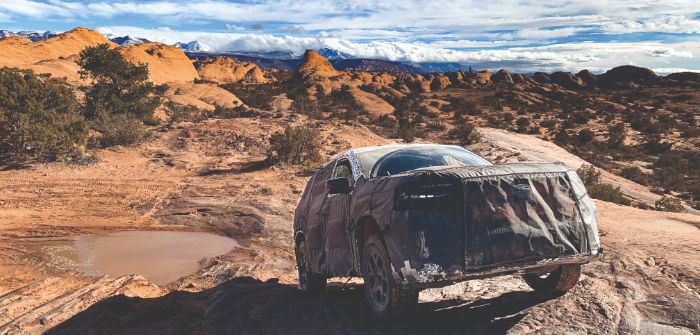From family hauler to trail-ready transportation: Honda engineers went the extra mile to give the SUV serious off-road chops
Rugged derivatives of city-focused SUVs are all the rage in North America, but that wasn’t the case when engineers at the Honda Auto Development Center in Ohio began to consider an off-road-ready version of their own Pilot in 2018. To prove the concept, the team fitted a previous-gen example of the three-row SUV with all-terrain tires, a skid plate and increased ground clearance, then assessed its trail performance in Lake Arrowhead, California.
Five years on, the all-new 2023 Pilot TrailSport production car brings new credibility to the TrailSport badge thanks to a package of carefully developed off-road hardware.
The team consulted with the Nevada Automotive Test Center to determine what was needed to make the Pilot better off-road and create a matrix to guide the development of TrailSport vehicles. Engineers also turned to Honda’s Powersports division for direction on skid-plate design and evaluation.
They opted for high-strength-steel items that could support the full weight of the car at any point. After digital design and simulation to determine the initial configuration, test engineers jacked up the vehicle
at multiple points on the skid plate to measure any permanent deformation that resulted, iterating until any weak points were eliminated.
Hit the trail
Strength wasn’t only the criterion the plates had to meet, according to Abhi Sadananda, durability leader
for the Pilot.
“It’s important in an OEM solution like this that it works not only as a skid plate but as an integrated part
of the whole car,” he explains. “In the concept stage, the crash group used simulation to understand whether their crash mode was impacted [by the plates]. The aero group conducted CFD simulations to understand the airflow with and without the plate, to ensure we still met aero targets.”
Evaluations on the necessary vents and NACA ducts in the plates included a drive on sand at Outer Banks on the US Atlantic coast in North Carolina to replicate a drive to a beach house, to check that debris had the necessary egress points and that there was sufficient cooling flow to prevent overheating. This was one of 17 off-road venues across the country where the TrailSport’s performance was evaluated – on dirt, sand, rocks, water, V-ditches and slopes – to ensure it could handle the 52% of trails on US public land that are deemed ‘easy’ or ‘moderate’.
“We drove the vehicle in West Virginia, Kentucky and Ohio,” adds Sadananda. “We used four different trails in Sedona, Arizona, including Cliffhanger and Schnebly Hill, which are popular tourist destinations for off-roaders. And in Moab, Utah, we went on Hell’s Revenge, Fins and Things, and Sevenmile Rim. We tested it to the limit.”
Cut the crap
Cooling was an important consideration when developing the TrailSport hardware. Colleagues from Powersports alerted the Pilot team to how debris from tall grass, mud and even combustible animal waste can cause problems if trapped between a skid plate and the part it’s protecting. “How do we test for feces?” pondered Abhi Sadananda. “That was a fun conversation.”


